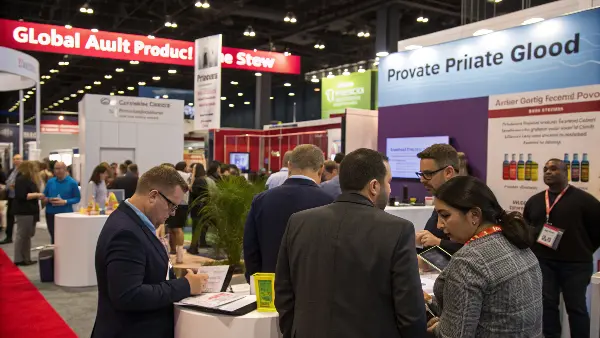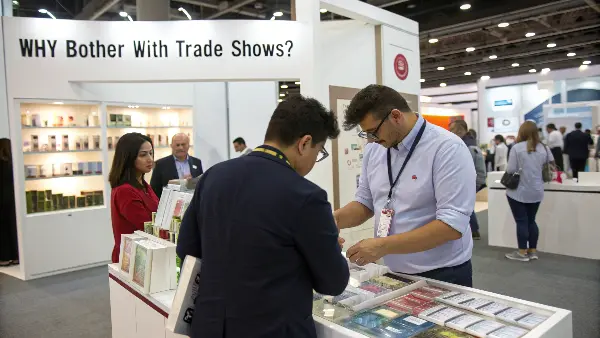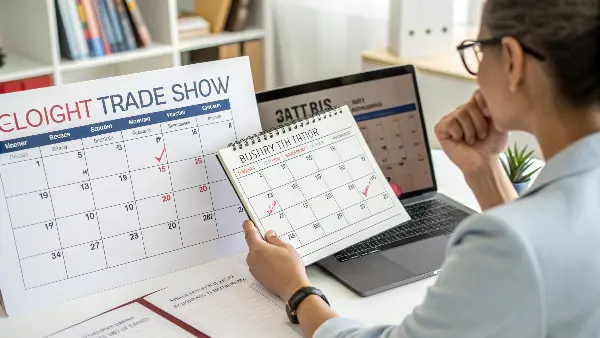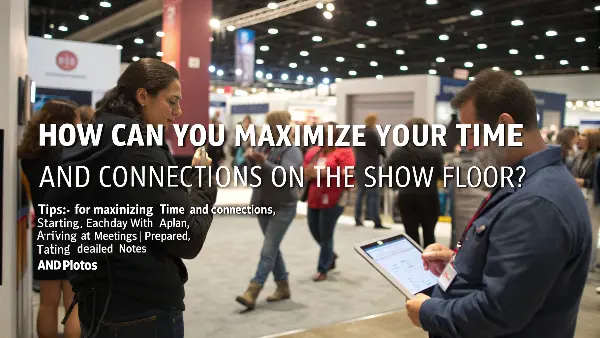Are you tired of endless online searches for the right manufacturing partner? The process can feel overwhelming, and you risk tying your brand to a supplier who delivers inconsistent quality. What if you could meet dozens of vetted suppliers and discover innovative products all in one place?
Attending global adult product trade shows is a powerful strategy for private label brands. These events let you meet manufacturers like us at PrivyPlay face-to-face, discover the latest product innovations, and vet potential partners directly. This physical interaction helps you avoid the risks of online-only sourcing and builds a foundation for a stronger, more reliable supply chain for your business. It secures your brand’s future.

I know what you might be thinking. Aren’t trade shows just expensive, time-consuming events? For a brand owner or sourcing manager with a million things to do, the investment in time and money has to be worth it. I’ve been in this industry for years, both attending and exhibiting at these shows, and I can tell you they are absolutely critical for serious brands. Let’s break down exactly why they are not just worthwhile, but essential for growth, and how you can create a strategy that delivers a real return on your investment.
Why Should Your Private Label Brand Even Bother with Trade Shows?
You see announcements for big industry trade shows, but the cost of flights, hotels, and tickets makes you hesitate. Is it just a big, expensive networking party? Sticking to emails and sourcing platforms can leave you feeling disconnected, missing the nuances of a product’s feel and a supplier’s true capabilities.
For a private label brand, trade shows are invaluable. They allow you to physically inspect product quality, discover emerging trends before they hit the market, and build personal relationships with manufacturers. This direct engagement fosters trust and better communication, which are critical for developing custom products and ensuring a stable supply chain. It’s about de-risking your business and gaining a competitive edge.

These events offer a return on investment that goes far beyond a simple supplier list. It’s about building a resilient and forward-thinking brand. Seeing and touching a product is something no video call can replicate. You can feel the quality of the silicone, test the motor’s vibration patterns, and check the finish on the plastic. This hands-on experience is the single best way to vet product quality before you commit to an order. It’s your first line of defense against receiving a container of products that don’t meet your brand’s standards.
The Power of Human Connection
Building a successful private label brand relies on strong partnerships. In my culture, we have a concept called guanxi (关系), which is about the power of personal relationships and trust in business. Trade shows are the ultimate place to build guanxi. You get to meet the people behind the company, from the sales team to C-level executives like me. You can ask direct questions and see how they respond. Do they understand your brand vision? Are they passionate about their work? This face-to-face interaction tells you more about a potential partner’s reliability and culture than any email chain or website ever could.
A Window into the Future
Trade shows are where manufacturers debut their latest innovations. You get a sneak peek at new technologies, materials, and design trends months before they become mainstream. This is a massive competitive advantage. You can identify the next bestseller for your store and start the development process with a manufacturer right then and there. Instead of reacting to the market, you can lead it. You might discover a new type of eco-friendly material or a motor technology that’s quieter and more powerful, allowing you to create a product that truly stands out.
How Do You Choose the Right Trade Show for Your Niche?
You’ve decided to go, but now you see a calendar full of events across the globe. Which one is right for you? Attending the wrong show is a waste of money and, more importantly, your valuable time. Every show has a different focus and attracts a different crowd.
To choose the right trade show, you must first define your goals. Are you looking for high-end luxury manufacturers, affordable bestsellers, or specialists in kink or BDSM products? Research shows like ANME, XBIZ, and the Canton Fair. Examine their exhibitor lists from previous years and see if the manufacturers align with your brand’s price point, quality standards, and product category. This targeted approach ensures you invest in the event with the highest potential return.

Making the right choice starts with a clear understanding of your brand’s needs. Don’t just follow the crowd to the biggest or most famous show. A smaller, more specialized event might offer a higher concentration of the exact partners you’re looking for. A little homework upfront will save you from walking an exhibition hall for two days and coming away empty-handed. This is about strategic investment, not just attendance.
Key Global Trade Shows for Sourcing
To help you get started, here is a breakdown of some of the most important trade shows for adult product brand owners and sourcing managers. Each offers a unique opportunity depending on your sourcing strategy.
| Trade Show | Location | Primary Focus | Best For |
|---|---|---|---|
| ANME (Adult Novelty Manufacturers Expo) | Burbank, CA, USA | B2B Networking, Distributors, Retailers | US-based brands looking to connect with domestic distributors and see US market trends. Good for networking. |
| EroFame | Hanover, Germany | Major European B2B Trade Fair | Brands focused on the European market. A huge range of exhibitors from across the continent and Asia. |
| XBIZ | Los Angeles, CA / Miami, FL, USA | Industry Networking, Digital Media, Retail | A blend of pleasure products, digital content, and industry networking. Strong focus on the future of the industry. |
| Canton Fair (Phase 2) | Guangzhou, China | General Consumer Goods, Health Products | Sourcing managers looking for direct-from-factory pricing. Our category (personal care/health) is in Phase 2. |
| HKTDC Hong Kong Electronics Fair | Hong Kong | Electronics and Components | Brands developing tech-focused toys. Excellent for finding suppliers of motors, chips, and charging tech. |
This table is just a starting point. Dig into each show’s website. Review last year’s floor plan and exhibitor list. See if the companies exhibiting match the kind of partner you need. If you’re a luxury brand, a show focused on mass-market goods might not be the best fit. If you are starting out and need low MOQs, look for shows that welcome smaller brands.
What’s the Secret to Preparing for a Successful Trade Show Visit?
You’ve booked your ticket and hotel. Now what? Showing up unprepared is like walking into an exam without studying. You’ll wander aimlessly and miss crucial opportunities. The most successful people at trade shows are the ones who did their homework weeks in advance.
The secret to a successful visit is meticulous pre-show planning. At least a month before the event, study the exhibitor list and floor map. Identify your top 10-15 potential manufacturing partners and schedule meetings with them in advance. Prepare a "brand kit" with your company info, product requirements, and target costs. This professional approach shows suppliers like us that you are a serious partner.

Your work for the trade show begins long before you step on the plane. The goal is to transform your visit from a random walk into a series of highly productive, pre-planned meetings. This not only maximizes your time but also makes a powerful first impression on potential partners. When you arrive at a booth with a scheduled meeting and a clear set of questions, it signals that you are professional, organized, and ready to do business.
Your Pre-Show Action Plan
Success is in the details. Don’t leave things to chance. A structured approach will help you navigate the chaos of a busy show floor and achieve your objectives. Here is a simple checklist I use myself when preparing to attend a show as a buyer:
-
Define Your "Why": What is your number one goal for this show? Is it to find a supplier for a specific new product? To find three potential backup suppliers for your bestselling item? Or to research a brand new product category? Write it down and keep it top of mind. This clear objective will guide all your decisions.
-
Scout the Exhibitors: Go to the trade show’s website and download the exhibitor list and floor map. Don’t just glance at it. Create a spreadsheet. Categorize exhibitors into "Must-See," "Good to See," and "If Time Allows." Research the "Must-See" companies. Visit their websites. Do their products and capabilities align with your brand?
-
Book Your Meetings: This is the most critical step. Do not wait to show up at the booth. Reach out to your "Must-See" list via email at least two to three weeks before the show. Introduce your brand, state your interest, and request a specific meeting time. This guarantees you dedicated time with the right person, not just a random salesperson at a busy counter. I always prioritize meetings with people who have scheduled them in advance.
How Can You Maximize Your Time and Connections on the Show Floor?
The trade show floor is a sensory overload. It’s loud, crowded, and overwhelming. It’s easy to get distracted by flashy booths and lose track of your goals. Without a clear plan of action for the day, you can easily end up just collecting brochures and free pens.
To maximize your time, start each day with a plan. Use your pre-scheduled meetings as the backbone of your schedule. Arrive at each meeting prepared with specific questions about capabilities, MOQs, lead times, and quality control. Use the time between meetings to walk specific zones of the show floor, and take detailed notes and photos (where permitted) for every promising interaction. Don’t forget to get a business card.

Think of yourself as a journalist on an assignment. Your mission is to gather intelligence. Every conversation is an opportunity to learn something, even if the supplier isn’t a perfect fit. They might give you a piece of information about a new material or a market trend that proves valuable later. Stay focused and stick to your plan, but also be open to unexpected discoveries.
The Art of the Booth Visit
When you walk up to a booth, whether for a scheduled meeting or a spontaneous visit, your approach matters. Don’t just ask, "So, what do you do?" That tells me you haven’t done your homework. Instead, lead with a focused and informed approach. Here’s how to make every interaction count:
-
Lead with Your Needs: Start with a concise introduction. "Hi, I’m [Your Name] from [Your Brand]. We specialize in [Your Niche], and I’m here looking for a manufacturing partner for a new line of waterproof vibrators with a target retail price of $80. I saw on your website that you have experience with silicone overmolding." This immediately frames the conversation and makes it productive.
-
Ask the Right Questions: Have a list of standard questions ready for every potential partner. This allows you to easily compare them later.
- What are your Minimum Order Quantities (MOQs)?
- What are your standard production lead times?
- Can you share details about your quality control process? (e.g., Do you perform 100% function testing?)
- What certifications do you have (e.g., ISO, CE, RoHS)?
- Do you have experience shipping to my country (USA/Europe/Australia)?
-
Document Everything: After each significant conversation, step aside and take a moment to write down your notes. Staple their business card to your notes page. I often take a quick photo of the person I spoke with (with their permission) to help me remember them later. On the back of their business card, I’ll jot down a key takeaway from our talk. These small actions are a lifesaver when you get back to the office and have a pile of 50 business cards.
Conclusion
Trade shows are more than just an expense; they are a strategic investment in your brand’s future. They provide an unmatched opportunity to vet suppliers, touch and feel products, and build the personal relationships that are the bedrock of a reliable supply chain. It’s your best defense against quality issues and your direct path to innovation.
